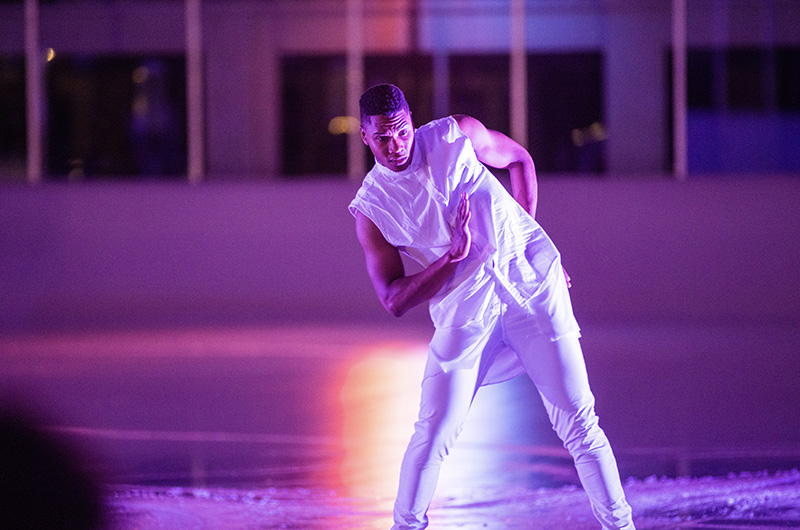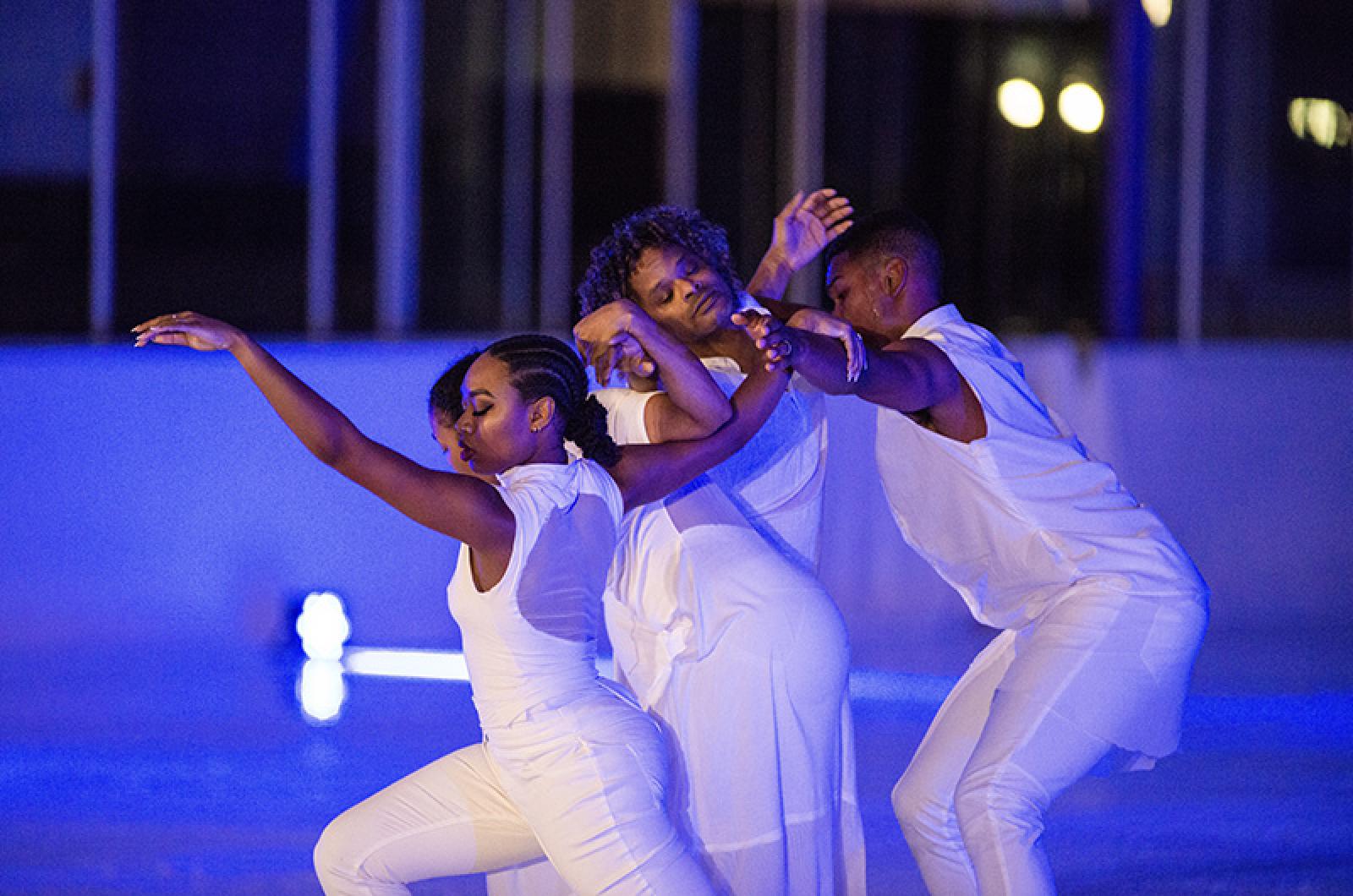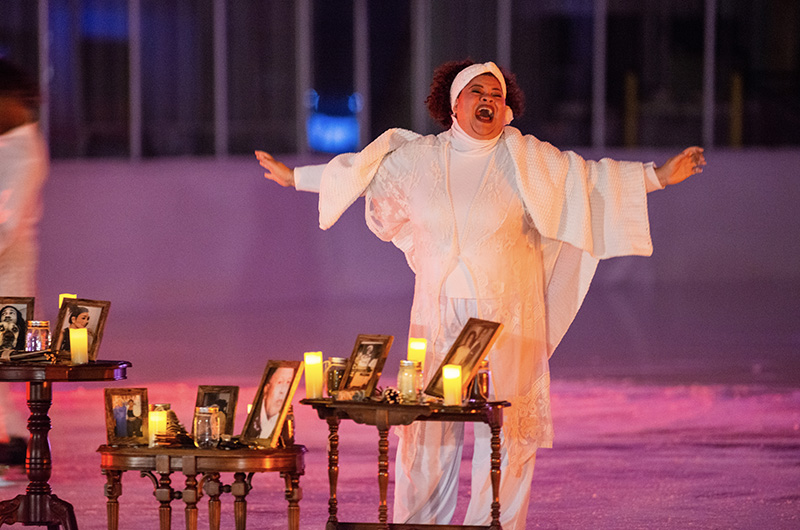The Martha’s Vineyard Ice Arena was transformed last Friday into a site of memory, spirituality and resistance, led by the Minneapolis-based dance troupe Brownbody.
The event, called Tracing Sacred Steps, was put on by The Yard as part of its 50th anniversary summer season. Unlike typical dance companies, Brownbody performs entirely on the ice, combining the technicality and precision of figure skating with the expressive freedom of modern dance.
Deneane Richburg, artistic director and founder of Brownbody, first visited the arena in 2018 to watch the Canadian ice dancing group Patine Libre, also hosted by The Yard. This summer, she returned as part of her company’s first-ever tour.
“I’m a firm believer that anything you can do on the ground can be done on the ice,” Ms. Richburg said at a talk-back after the show.
The show opened with a rendition of the Urban Bush Women’s Give Your Hands to Struggle, re-staged for the ice and performed by Ms. Richburg.
Audience members had the opportunity to sit directly on the ice (covered in a well-insulated carpet) and engage with the performance head-on. Although The Yard has hosted many site-specific events outside of their Chilmark studio, executive director Chloe Jones noted that setting up on an ice arena can be particularly challenging.
“Our production team has been working hard,” Ms. Jones said. “[Ice performance] is an entirely different animal, and we’re so grateful for all of the effort that went into making the show happen.”
The result was an immersive, deeply personal and transcendent body of work. In one piece, entitled Haunting Rage Resistance, performed by Joey Millet, Chelsea Ridley, Steven Smith and Ms. Richburg with narration and vocals by Thomasina Petrus, the ice dancers told the story of the Duluth Lynchings in 1920 Minnesota, in which three Black men were lynched by a local mob and photographs of the killings were made into postcards.
Traditionally, ice dancing and figure skating operate within balletic conventions, prioritizing fluid, elegant motion, strict gender roles and, above all, composure. Haunting Rage Resistance diverged from these conventions as dancers writhed, stomped and shouted their grief, bringing modern expressibility to the traditional medium.
By intermission, the arena’s previously liquid-smooth floor was covered in ice chips, its surface cracked and webbed like skin stretched over a scab.
The themes of grief and memory — and the perversions thereof — continued with Sanctuary. Candles and photos of deceased loved ones and ancestors lined the stage, culminating in a small shrine in the corner. Rather than segmenting discrete acts, performers acknowledged each other as they moved in and out of the space, creating a continuous stream of performance. The choreography and design process was deeply collaborative, the performers said, and dancers were encouraged to translate their own emotional landscape to the work.
“A year before we started working on the piece, my mom died,” Mr. Smith shared. “Then the pandemic hit, and six months after that, my father died, then my sister. By the time we returned, I was a completely different person. I couldn’t approach it in the same way.”
For the piece, Ms. Richburg said she drew inspiration from the African American Ring Shout, one of the first known dances by the African diaspora. The Ring Shout takes precedent from West African circle dances and involves a group performing footwork in a counterclockwise ring while an individual shouts in the center, channeling spiritual ancestors. On the ice, Ms. Petrus’ piercing vocals served as the focal point for the dancers’ frenetic movement, with each performer falling in and out of sync as if to show the undulating relationship between individual and community.
“As a figure skater, we were always trained to perform in a counterclockwise direction,” Ms. Richburg said. “I saw that connection and looked for how to bring this sacred practice to what we were doing.”

Before founding Brownbody, Ms. Richburg was a competitive figure skater who felt that she had to “check her Blackness at the door.” Part of Brownbody’s mission, she said, is to cultivate a space for Blackness in the predominantly white world of ice skating. But that mission doesn’t come without obstacles, she added. Hourly ice arena rates can reach up to $225 in-season, Ms. Richburg said, and she has found that it’s often necessary to reserve extra “buffer time” around practice to protect her group from harassment.
“We once had a site cancel on us with a week’s notice. They didn’t even give a reason,” Ms. Richburg said. “There’s no space for Blackness or complex, multidimensional storytelling, or really anything other than hockey.”
“We’re not going anywhere,” Ms. Richburg added. “Brownbody will always exist, but it’s definitely one of my current frustrations.”
The Yard’s summer programming culminates on August 26 and 27 with preview performances of Underscored by Ephrat Asherie Dance. The Martha’s Vineyard Museum is also hosting the retrospective, Let’s Dance! 50 Years of The Yard, at the Waggaman Community Gallery, on view now until Oct. 21.
For more information on The Yard’s upcoming events, visit dancetheyard.org.









Comments
Comment policy »